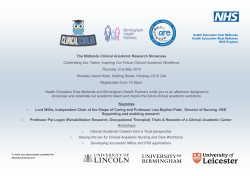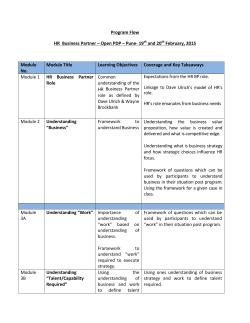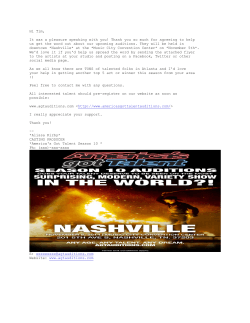
DRIVING WORKPLACE DIVERSITY
10 mystarjob.com, Saturday 18 April 2015 By SALIKA SUKSUWAN editor@leaderonomics.com A S a Malaysian, I’d like to believe that having a diverse circle of friends and colleagues in the workplace is a way of life for us. However, I find diversity in the workplace isn’t necessarily an area of focus in many organisations. In broad terms, workplace diversity refers to the variety of differences between people in the organisation, which includes ethnicity, gender, age, where we come from, and our educational background. We can harness workforce diversity if we have a culture of inclusion, which respects our differences and ensures that we encourage each person to reach their full potential. Simply put, diversity is a mix of different individuals; inclusion is getting these individuals to work well together. Focus on diversity and inclusion (D&I) As Malaysians, we often say “diversity is a source of strength”. However, not many organisations have concrete plans to enhance diversity in the workplace. Some multinationals are using metrics or diversity scorecards to measure progress in hiring, promoting and retaining their workforce whilst in most organisations, “diversity” is deemed a buzzword, not a core focus of their people initiatives. I recall a human resources (HR) leader saying D&I is very Americancentric, and not quite relevant in their organisation. On the contrary, the HR team can influence their business leaders if we believe a diverse workforce makes a difference to the business. The business case for diversity can be anchored on these key reasons: l It’s the future workforce; and l It drives better business performance. 1 The future workforce is diverse An Accenture study outlines the need to better prepare our organisation to be future-ready. The study describes the five major shifts that are reshaping work in Asean, as illustrated below (Figure 1). In responding to this change, organisations need to move towards new ways of working which will be more appealing to a mutigenerational and diverse workforce. This requires HR leaders to work alongside their corporate captains to drive a more flexible, collaborative, and inclusive culture. 2 Diversity drives business performance A number of surveys illustrate that diversity is increasingly becoming top-of-mind for CEOs globally. A PwC driving workplace diversity GETTING OrganisationS ‘future-ready’ survey indicates 77% of CEOs globally have, or intend to adopt, a strategy promoting D&I. A recent McKinsey research illustrates that companies who commit to diverse leadership are more successful. Companies in the top quartile for gender diversity were 15% more likely to have financial returns above their national industry medians (Figure 2). Similarly, companies in the top quartile for ethnic diversity were 35% more likely to have better returns. Research on diversity shows that a diverse workforce provides positive outcomes in these areas: l Talent attraction: because they are underrepresented, groups targeted by diversity efforts are often good sources of desirable talent. l Strengthen customer orientation: companies with a more diverse workforce forge stronger bonds with increasingly heterogeneous customers. l Increase employee satisfaction: a diverse workforce encourages positive attitudes and behaviours, and reduces conflicts between groups. l Improve decision making: a diverse workforce fosters innovation and creativity through a greater variety of problem-solving approaches, perspectives and ideas. HR leading the change HR plays a key role in moving the needle on diversity. Aside from raising awareness and celebrating diversity in organisations, HR teams should place greater focus on: l Considering a wider talent pool in talent sourcing efforts; and l Reviewing retention strategies to address the needs of a more diverse workforce. Figure 1 Multigenerational and diverse workforce that includes previously untapped talent as well as the need to have more women in the workforce. High levels of digital competencies and a mind-set of collaboration. Leaner, less hierarchical organisation structures with collaborative groups of leaders leading to flatter organisation structures and lines of reporting. Flexible approaches to sourcing talent with increased leverage of freelancers and partnerships with external players. Source: The Future-Ready Organisation, Reinventing Work in Asean (Accenture Strategy) Women in Senior Management Position 58 54 +15% 47 +35% 4th quartile 1st quartile Gender diversity Figure 4 Gender breakdown at senior management level Likelihood of financial performance above national industry median, by diversity quartile % 43 4th quartile 1st quartile Ethnic diversity Source: “Diversity Matters”, McKinsey and Company, February 2015 % 45 40 35 30 25 20 15 10 5 0 2009 2010 2011 2012 2013 Year Source: Maybank Sustainability Report 2013 Figure 3 workers will consider giving up higher pay for: 64% THE OPPORTUNITY TO LEARN NEW SKILLS 54 % 1 Talent sourcing Malaysian organisations often cite talent crunch as a key business challenge. The World Bank highlighted that 48% of companies surveyed identified the lack of talent as a constraint for future growth. Organisations which prioritise talent diversity will be more prepared to tap into a wider talent spectrum beyond conventional talent sourcing channels. This includes casting the net to recruit latent talent and tapping on foreign talent, diaspora and alumni networks. We’ve begun to see some of these practices in corporate Malaysia: l In response to the Career Comeback grant managed by TalentCorp, Accenture recently 5 Major Shifts reshaping work in asean Highly customised work experiences to address the desire for meaningful, flexible work and continuous development. Figure 2 How diversity correlates with better financial performance A FLEXIBLE SCHEDULE 67% WORK-LIFE BALANCE Ideal work environment: 1 Flexible work arrangements 2 Exposure to the latest technologies and equipment 3 Competitive, where the towards and riskd are high 4 Rapid pace with constant change - always something new Source: KellyOCG Worker Preferences and Workplace Agility Study (2014) launched a referral programme which doubles up the referral rewards for staff who refer women returnees. SCOPE International organised a career fair for people with disabilities in conjunction with World Inclusion Day 2014. This initiative had strong support from their leadership team, with 80 candidates attending the event and eventually 15 of them were hired. Another pool of latent talent is managed by SOCSO, which has been running a successful Return to Work programme to place insured contributors back to the workplace as soon as it is medically possible for them to do so. l l With Malaysian organisations expanding their footprint regionally, more employers have started to tap into a more diverse graduate pool by recruiting international students from Asean countries. Malaysian public higher educational institutions have close to 30,000 international students, with a larger number in private higher educational institutions. These graduates are typically proactive and eager to secure employment in Malaysia and will add to the diversity of our talent pipeline. 2 Retaining the workforce Whilst our business is agile in responding to the needs of a changing customer base, we may not be paying enough attention to the needs of the changing demographics of our workforce. A recent study by Kelly Global Workforce Index shows that flexible work arrangements (FWA) are a key criteria in defining an ideal work environment for the Malaysian workforce, with 54% of respondents willing to forgo higher pay for FWA. HR leaders should consider whether fixed working hours – which requires standardised face-time for everyone – will be effective in retaining our future workforce, and whether the shift should instead be towards measuring work performance and outcomes (Figure 3). While a TalentCorp-PwC survey showed that under 35% of Malaysian PLCs provide FWA, it’s nevertheless a positive sign that organisations like Maybank are increasingly driving this shift, placing greater focus on D&I to close talent gaps and encourage better business performance. They have put in place a holistic retention strategy which includes mentoring programmes, FWA implementation, family-friendly facilities and a rigorous tracking of workforce dashboards on gender, age and ethnicity at all levels. These efforts have begun to show results, with Maybank enjoying a more diverse workforce at management levels (Figure 4). The workforce transformation in Maybank is driven by HR, with strong support from the leadership team. Moving forward While HR leaders are inundated with day-to-day people matters, we should still take the time to examine our workforce demographics. It may be easier to manage a homogenous workforce, but to quote Steven Covey, diversity is a key differentiator, as “strength lies in differences, not in similarities”. The first step is to be aware of our own biases and not allow it to come in the way of decisions on hiring, developing and retaining our people, as we work towards being the driver of change in developing a diverse workforce. n Salika Suksuwan is on secondment to TalentCorp to do her part in nation building. She dreams of a future when Malaysian corporations will truly believe in harnessing the strength of a diverse workforce to grow their organisations to be regional and global champions. To connect with Salika, email editor@leaderonomics.com
© Copyright 2025









